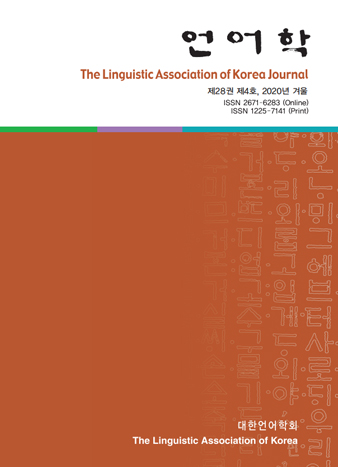대한언어학회 전자저널

28권 4호 (2020년 12월)
- 전남어의 의문문 억양 경계톤에 대한 강세구초 자음의 원거리 효과
-
오미라
Pages : 51-75
Abstract
Oh, Mira. (2020). Longdistance effect of the APinitial consonants on interrogativefinal boundary tones in Chonnam dialect of Korean. The Linguistic Association of Korea Journal, 28(4), 51-75. This study explores the factors which affect the shapes of boundary tones in Korean interrogatives. 26 Chonnam speakers produced three types of interrogatives in Korean, (i.e., simple polar questions, whquestions, and indefinite pronoun questions) under variation in verbinitial consonants and question endings. A phonetic analysis of their production reveals three results. First, the initial segment of the Intonation Phrase (IP)final Accentual Phrase (AP) plays a significant role in determining the shapes of boundary tones. Second, the distribution of various boundary tones is different across the three types of interrogatives in Korean. Third, the lexical ending forms also condition the shapes of boundary tones. I propose that the APinitial consonant effect weighs more than the constraints for different types of interrogatives, which are in turn more weighted than the effect of the ending form. I test the validity of the proposed weighted constraints by the learned grammar in the Maximum Entropy Model based on the frequency of each boundary tone. This study shows that the differently weighted factors interact to produce various boundary tones in Korean interrogatives.
Keywords
# 경계톤(boundary tones) # 전남 지역어(Chonnam dialect of Korean) # 의문문 유형(types of interrogatives) # 강세구 초 자음(AP-initial consonants) # 종결 어미 형태(lexical ending forms)
References
- 고광모. (2001). 반말체의 등급과 반말체 어미의 발달에 대하여. 언어학, 30, 3-27.
- 서정목. (1987). 국어 의문문 연구. 서울: 탑출판사.
- 오미라. (2008). 운율과 정보구조: 한국어 초점과 주제의 음성적 실현. 음성과학, 15(2), 7-19.
- 오미라. (2020). 전남어의 억양구말 강세구 성조 연구. 언어, 45(3), 555-577.
- 오승신. (2006). 대화형 음성인터페이스시스템을 위한 국어 문말 경계억양의 분류. 인문논총, 56, 3-42. 서울대학교 인문학연구원.
- 윤영숙. (2014). 중국인 학습자들의 한국어 의문사 의문문과 부정사 의문문에 대한 한국어 원어민 화자의 지각양상. 말소리와 음성과학, 6(4), 37-45.
- 이병운. (1998). 중부방언, 경남방언, 전남방언의 억양에 대한 비교 연구. 우리말연구, 8, 1-62.
- 이호영. (1996). 국어 음성학. 서울: 태학사.
- Bolinger, D. (1989). Intonation and its uses: Melody in grammar and discourse. Stanford: Stanford University Press.
- Chung, S., & Kenstowicz, M. (1997). Focus expression in Seoul Korean. Harvard Studies in Korean Linguistics VII, 93-105.
- Goldwater, S., & Johnson, M. (2003). Learning OT constraint rankings using a maximum entropy model. In Proceedings of the Stockholm Workshop on Variation within Optimality Theory, 111-120.
- Gussenhoven, C. (2002). Intonation and interpretation: Phonetics and phonology (Electronic version). In Speech Prosody 2002, 47-57
- Hwang, H. (2007). Wh‐phrase questions and prosody in Korean. In Proceedings of the 17th Japanese and Korean Linguistics Conference, 295‐310.
- Jun, S. (1993). The phonetics and phonology of Korean prosody. Unpublished doctoral dissertation, Ohio State University.
- Jun, S. (1996). Influence of microprosody on macroprosody: A case of phrase initial strengthening. UCLA Working Papers, 92, 97-116.
- Jun, S. (1998). The accentual phrase in the Korean prosodic hierarchy. Phonology, 15, 189-226.
- Jun, S. (2000). K-ToBI (Korean ToBI) Labeling conventions. Retrieved from http://www.humnet.ucla.edu/humnet/linguistics/people/jun/ktobi/Ktobi.html.
- Jun, S. (2005). Korean intonational phonology and prosodic transcription. In S. Jun (Ed.), Prosodic typology: The phonology of intonation and phrasing (pp. 201‐229). Oxford: Oxford University Press.
- Jun, S. (2011). Prosodic markings of complex NP focus, syntax, and the pre-/post-focus string. In Proceedings of the 28th WCCFL, 214–230.
- Jun, S., & Oh, M. (1996). A prosodic analysis of three types of wh-phrases in Korean. Language and Speech, 39, 37‐61.
- Jun, S., & Oh, M. (2003). Acquisition of second language intonation. Language Education, 10, 41-54.
- Park, M. J. (2003). The meaning of Korean prosodic boundary tones. Unpublished doctoral dissertation, UCLA.
- Prince, A., & Smolensky, P. (1993). Optimality theory: Constraint interaction in generative grammar. Unpublished manuscript.
- Ueyama, M., & Jun, S. (1998). Focus realization in Japanese English and Korean English intonation. Japanese and Korean Linguistics, 7, 629-645.
- Wilson, C., & George, B. (2009). MaxEnt grammar tool. Retrieved from http://www.linguistics.ucla.edu/people/hayes/MaxentGrammarTool.
- Yun, J. (2017). Sentence-final intonation in Korean. Paper presented at ICKL 2017, Helsinki, Finland, 27-29 June.